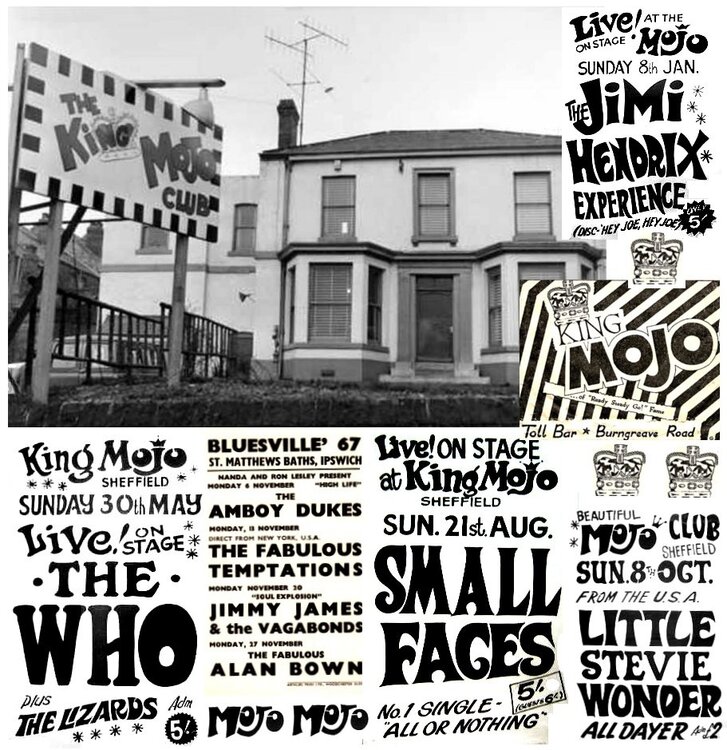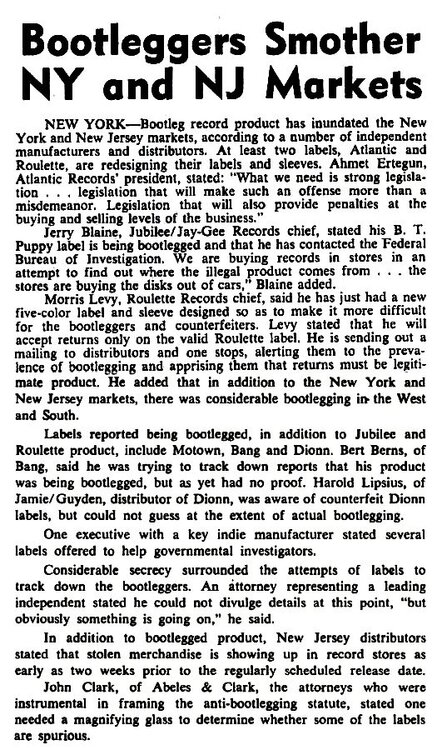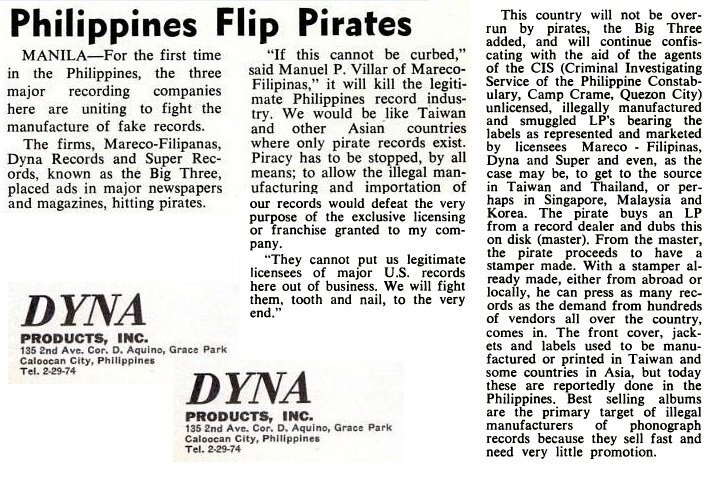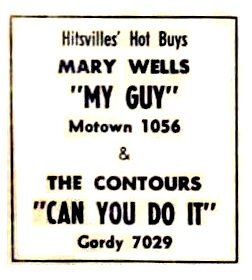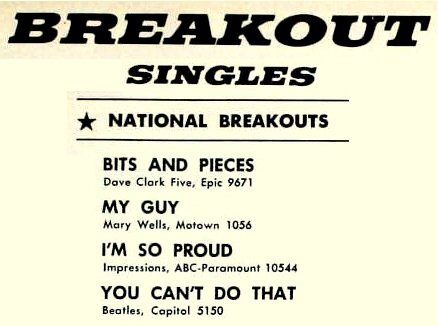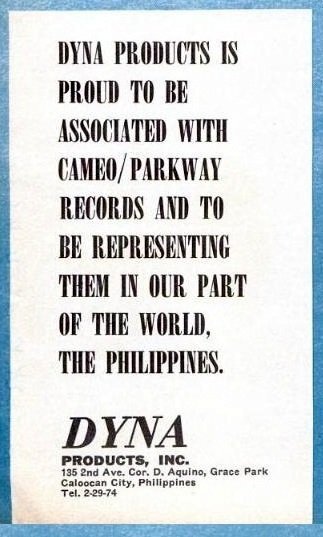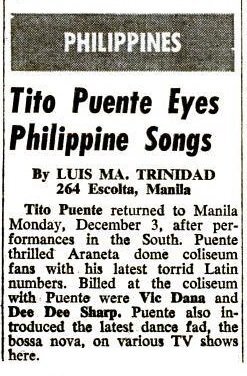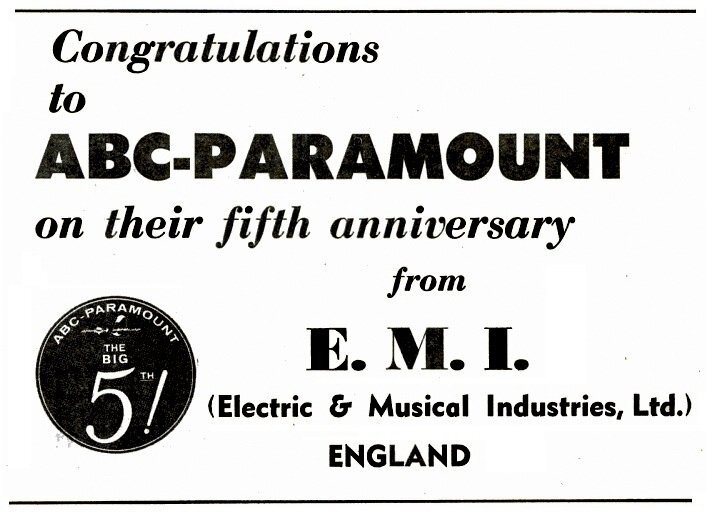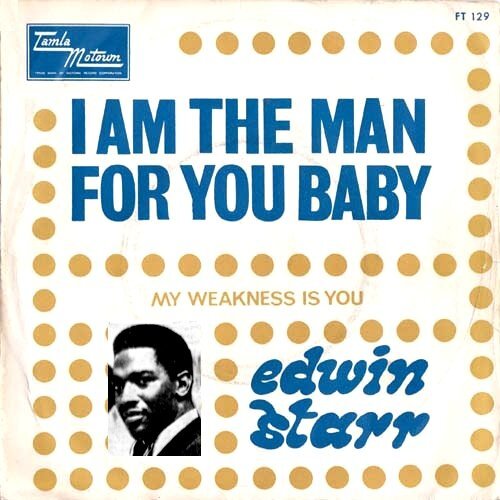-
Posts
7,237 -
Joined
-
Last visited
-
Days Won
45 -
Feedback
0%
Content Type
Forums
Event Guide
News & Articles
Source Guidelines and Help
Gallery
Videos Directory
Source Store
Everything posted by Roburt
-
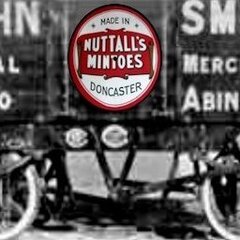
The Wheel And Late 60S Proto Northern Soul Scenes
Roburt replied to Ady Croasdell's topic in All About the SOUL
Did the Crystal Bowl in Caselford (where Stringfellow held some niters after the Mojo was closed down) become the Tinned Chicken ?? Think that hosted some niters under the Tinned Chicken name (68-ish I think). -
Billy Wells was originally from Cleveland. He was a big SciFi fan, hence all his group's names after he moved to Florida (Outer Limits, Invaders). Same guy who had been with the Crescents.
-

The Wheel And Late 60S Proto Northern Soul Scenes
Roburt replied to Ady Croasdell's topic in All About the SOUL
The niter biggies back around 67/68/69 are all stuff that the youngauns now call 'youth club sounds ' ............ "I Dig Your Act" "Nothing Else To Say", "Whats Wrong With Me Baby", "Slippin Around", "Open The Door", "Call On Me", "You Can Lead Your Woman, "Washed Ashore", "With This Ring", "You've Been Cheatin" which was just replacing stuff by the likes of Lee Dorsey, Sam & Dave, Don Covay, Joe Tex, J & B Purify, Rufus Thomas, William Bell, etc. -

The Wheel And Late 60S Proto Northern Soul Scenes
Roburt replied to Ady Croasdell's topic in All About the SOUL
Sully (John Sullivan) was one of 'our' Dony crowd .... knocked about with him every week for a few years in the mid 60's. -

The Wheel And Late 60S Proto Northern Soul Scenes
Roburt replied to Ady Croasdell's topic in All About the SOUL
...... OFF THE NET ................. posted up by C J Smith (no relation) ............. I played guitar in a couple of R n’ B bands but it was while playing the church organ that the local band, The Liberty Takers, heard me playing and recruited me, presenting me with a Vox Continental. In 1966 we metamorphosed into a Soul Band with a black singer, Nelson Fletcher, and became ‘Ellison’s Hog Line.’ We got into the final of one of those band competitions at the Spinning Disc in Leeds, and were pipped at the post by a professional group from Liverpool called the Remo Four. An army of Mods came from Harrogate to support us and the place was packed. Some nights with the Hog Line we played as many as 3 gigs at places with exotic names like ‘The Boston Starlight,’ The TADCASTER BOULEVARD,’ and ‘The Blue Gardenia’ (aka the BEE GEE club on a backstreet in Leeds.) Because the place was so packed with Mods, the only way in was to load our equipment down through the beer barrel hole straight onto the stage. We’d do our 45 minute set and hand the amplifiers back up to Keith, our roadie, a sainted man who got us out of many scrapes. -

Nite Owl Leicester,dungeon And Beachcomber Nottingham
Roburt replied to a topic in All About the SOUL
I still knock about with Tom (he lives outside Worksop now). I take him to Cleggy weekeders (& used to take him to Prestatyn as well). Its his 65th birthday next September & he's having a big soul party. You know me as well Chris. -

The Wheel And Late 60S Proto Northern Soul Scenes
Roburt replied to Ady Croasdell's topic in All About the SOUL
Already posted this list on the Nite Owl thread but hey ho ............ ...................... Nite Owl live acts back in 1967. ..... some details of the live acts who appeared at the club back then ........ APRIL 8th 67 > Alan Bown Set APRIL 15th 67 > Wynder K Frog .... last allniter at Mojo (Sheffield) with Geno Washington & RJB on live. MAY 6th 67 > Pesky-Gee >> didn't attend. Saw Garnett Mimms (+ Jimi Hendrix) at Saville Theatre, London on Sunday 7th MAY 27th 67 > Powerhouse JUNE 3rd 67 > Pesky-Gee & Jimmy Cliff JUNE 10th 67 > no idea who on. Went to Hull Skyline on Thurs 8th > Lucas + Mike Cotton Sound. Frid 9th Jungle in Brid. JUNE 17th 67 > Wynder K Frog & Pesky-Gee ADVERTISED AS > Sonny Childe & TNT JUNE 24th 67 > Family (before group became folk rock outfit) July 15th 67 > ????? >> went to Mojo Alldayer on Sun 16th > (fake) Drifters on live July 22nd 67 > Pop Toniks July 29th 67 > Wynder K Frogg didn't attend > went to Mojo Alldayer on Sun 30th > Garnett Mimms on live August 5th 67 > Shevelles ........ group failed to show up August 19th 67 > Reg James Explosion > then up to Mojo alldayer (Alan Bown + Wynder K Frogg) August 26th 67 > Ferris Wheel + Shevelles September 2nd 67 > Temptations (really Velours) + Pesky-Gee >> Sunday Mojo alldayer > Temptations again September 9th 67 > Cliff Bennett + the Peeps September 16th 67 > Root & Jenny Jackson September 23rd 67 > Garnett Mimms >>>>> I went to Mojo Allniter > Drifters then Sunday Mojo Alldayer > Garnett Mimms September 30th 67 > ????? >> I went to Mojo Allniter > Jimmy Cliff & Shakedown Sound October 7th 67 > Maxine Brown GREAT >> then on Sunday > Mojo Alldayer (last ever) > Stevie Wonder October 14th 67 > ??? went to Wheel > Jnr Walker & AllStars October 21th 67 > Alan Bown October 28th 67 > Isley Brothers (fake - really Sam, Erv & Tom > 3/4 of Diplomats) November 4th 67 > Drifters (fake -- think it was actually the Invitations again) November 11th 67 > Max Baer & Chicago Setback November 18th 67 > Jimmy James & Vagabonds November 25th 67 > ??? >> went to Wheel > Ben E King & Senate + Amboy Dukes December 2nd 67 > Eddie Floyd .... MONDAY 4th December 67 > Nite Owl closed down as no Local Authority licence granted. December 16th 67 > NO NITE OWL >> went to Wheel (our new home) to see the Vibrations. The main thing that had me attending niters every week back then was the live acts ........... a gudun almost every week. Other places that had live acts on just before 67 & after 1970 ............... a place outside Tadcaster at the side of the main Leeds to York road (the Boulevard maybe was its name) ........ .1966-ish A place in Goole in the early 70's that booked all the fake acts promoted by that infamous UK booking agent (Tempest ?). He got away with it for 2 years or so coz he always put on groups but when he started booking fake solo singers (Carla Thomas, etc) he was soon seen off. -

The Wheel And Late 60S Proto Northern Soul Scenes
Roburt replied to Ady Croasdell's topic in All About the SOUL
The Mojo wasn't the most ideal club for live acts. The club was housed in a converted house (see piccy above) and this property was long but thin. So the stage was at the very back of the building & the dressing rooms at the front. Acts had to walk right through the whole club to get on & off stage (a big problem for the blind Stevie Wonder). Pete always wanted his audience to get their money's worth .... so if say Ike & Tina put on a great show, when they finished he would tell the crowd not to let them off stage till they had done some more numbers ..... he wasn't the most popular guy with the acts when he did that. Didn't work well with Roy C though as 80% of his act was made up of repeated attempts at singing "Shotgun Wedding" ........... so he wasn't kept on stage for extra songs by Pete. -

The Wheel And Late 60S Proto Northern Soul Scenes
Roburt replied to Ady Croasdell's topic in All About the SOUL
Mod groups such as the Small Faces & Who made regular live appearances in the Mojo's mod days (I think the Faces 1st gig outside London was at the Mojo after they had been paid off by a sheffield working man club that had booked em to play). Stringfellow of course was always up on the latest sounds as he organised the dancers on every edition of RSG. -

The Wheel And Late 60S Proto Northern Soul Scenes
Roburt replied to Ady Croasdell's topic in All About the SOUL
The Mojo started around 64 after Pete Stringfellow had made some money putting a Beatles concert on in Sheffield. Most UK clubs back then were blues clubs (UK groups on mainly), so in the early days here (as at the Wheel) you got blues acts & records played. The mods started taking over & the sounds changed quickly to soul & ska. By 1965/66 it was a pure soul club (though some acts were still beat groups & future reggae guys -- Zoot Money, Jimmy Cliff, etc.). The normal sessions at the club (mid week) were more poppy but the niters were 100% soul & ska (with great US live acts). By 1967, the scene was progressing from the mod era & Stringfellow experimented with acts such as Jimi Hendrix & ex soul groups like Alan Bown, etc. --- but rock groups such as the Nice had just a few weeks earlier been backing bands for the likes of P P Arnold). The clubs decor was changed from mod to gangster to flower power theme (this last change coming in early / mid 67) and some non soul / ska stuff was played ("My Girl The Month of May"). However, mostly, the music & live acts were still soul. Acts on in last few weeks before club closed were Fantastics (who Stringfellow managed for a while), Drifters, Jimmy Cliff, Garnett Mimms, Stevie Wonder, etc. Last niter held on Sat 30th Sept & last session on Sunday 8th Oct 67 (alldayer with Stevie Wonder). Stringfellow always helped out the local students (the art students would decorate the club for him for beer & a few free nites at the place) and so live tracks were cut at the club in 64 / 65 / 67 (??) and student rag 45's put out locally. I have the 'last' Mojo cut EP which featured a local black group & (the also local) Joe Cocker. Cocker did a resonable version of an Impressions song ("I've Been Trying" I think). Council closed club down (by refusing it a license) on Tuesday 10th Oct 67. -

The Wheel And Late 60S Proto Northern Soul Scenes
Roburt replied to Ady Croasdell's topic in All About the SOUL
Yea, we made the mistake of booking our 67 summer holiday in Yarmouth ............ ... everyone else went to Newquay & Torquay in 67 (most to Newquay I seem to recall). However, there was a good soul crowd in Norwich in 67, so we spent much of the week hanging about with them. Yarmouth Tower Ballroom was crap that year (both discs, live acts & crowd). We hung out at Jaquard Coffee Bar in Norwich with local soulies & then went to a club (it may have been called The Disc). -

The Wheel And Late 60S Proto Northern Soul Scenes
Roburt replied to Ady Croasdell's topic in All About the SOUL
Loads of London area soul clubs like the Ram Jam ......... Ricky Tick, Windsor, Berkshire Royalty Ballroom, Southgate, London Flamingo, Soho Upper Cut, Forest Gate Tiles, Soho Starlite Ballroom, Greenford, Middlesex Marquee, Soho Bag O’Nails, Soho Cue Club, Paddington California Ballroom, Dunstable ..... & wasn't there some cellar club on Oxford St ?? -
.... & you had to be a very brave man to bootleg Morris Levy's 45's back in the mid to late 60's ............ .......... if he caught you, you would be hung out a 5th storey office block window no doubt ....
-
......... and problems 'off the beaten track' for the majors back in the US ............. An outfit operating out of New Mexico in 72/73 that were brought to book ...............
-
Bootlegging was always a big problem in the far east ................... ............ the fall-out from 1970 incidents ................
-
Then there was the infamous Raynoma / Mary Wells Motown 45 incident in March / April 64. I guess she got 'her copies' of "My Guy" made up at a 'non-standard' pressing plant ..... ........ so how do you tell her versions of that 45 from the legit Motown ones ??
-
Seems that bootleg records have been about since records started being made. The big ticket items are of course the NS items + big rock acts live gig records. But lots of other examples come to mind .................. ............. some dating back to the early 60's ................ What labels (types of music) did the Mark Record Co of Utica, New York put out (legitimate stuff) ??
-

The Wheel And Late 60S Proto Northern Soul Scenes
Roburt replied to Ady Croasdell's topic in All About the SOUL
There were lots of clubs that had live 'soul' acts on but didn't hold niters .............. Boston Starlight Room – Ferris Wheel Hull Gondola -- Chris Farlowe Bradford String Of Beads – Eric Burdon & The Animals type R&B groups + proper soul acts. Cleethorpes Purple Onion Club – Alan Bown, etc. Attic Doncaster -- Billy Stewart, Drifters, etc. Retford Broken Wheel -- lots of soul acts There were also lots of clubs on the south coast (Brighton, Portsmouth) that put on loads of live soul acts + in places such as Dunstable -

The Wheel And Late 60S Proto Northern Soul Scenes
Roburt replied to Ady Croasdell's topic in All About the SOUL
There were niter type venues in the West Yorks towns around the time after the Mojo / Nite Owl closed (late 67 thru into 68). Seem to recall places such as the Bin Lid in Dewsbury & clubs in Huddersfield / Bradford area. The Bee Gee in Leeds had been a mod / soul club around 66/67 but have no idea when that closed down. There was a big Hull soul crowd in 66/67 but many of those people drifted off the niter scene after the Mojo closed (some old Mojo-ites along with newer blood from Hull, Goole, Dony, Lincoln, Sheffield, Notts, Peterboro did start going to the Wheel but lots packed up niters). Of course the Notts lads had there own niter clubs (Dungeon, Beachcomber, etc). They held niters in Hull the odd time around 69/70 I seeem to recall (at the Discotheque on Whitefriar Gate). Always a big crowd from the Midlands at the Wheel (Kidderminster, Peterboro, Walsall, Brum area) so guess they didn't have their own niter after the Nite Owl closed. Course, after the Wheel, there was Up The Junction in Crewe & VaVa's. There were strong non-niter soul club scenes all across Yorkshire & down into Nth Notts (Broken Wheel, Retford). When did they start holding niters in Wakefield ? Back in the mid 60's, some of the Dony soulies would have a big night out & catch the train to London to attend some of the soul clubs around Paddington, Soho & Liverpool St areas -- but those trips were infrequent. -
The guy (lead singer) is obviously miming. So would the TV station people pre-record their track (to elimate any live mistakes) or did the group have to turn up with a tape that they (or their record label) had pre-prepared ?? I know its hard to say what went on with regard to this particular show. But then back in the 60's, every city had a TV stn that did a 'Bandstand' type music show & they will all have followed similar procedures / routines I guess.
-
I guess that with Dee Dee Sharp playing gigs there and dance 45's by the likes of Chubby Checker also being popular with locals, Cameo & Parkway were sure to have good local representation .............
-
Back to the Philippines for a second or two .......... The US military always had a large presence in the Philippines. The US navy had a big base at Subic Bay, whilst Clark Air Force Base was the home for 100's of American pilots. During the 60's (& into the 70's during the Virtnam War era) 1000's of Americans were either based there or took 'rest leave' on the islands. Because of this, American entertainers were regular visitors, with this fact being reflected in the number of records by American artists that were issued there. As early as 1962, the likes of Dee Dee Sharp & Tito Puete did shows there .....................
-
Of course, EMI represented quite a few US labels and put their stuff out around the world ..............
-
-
I'm sure I put a box full of Numero CD's in this bag earlier ........



